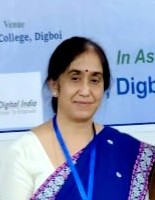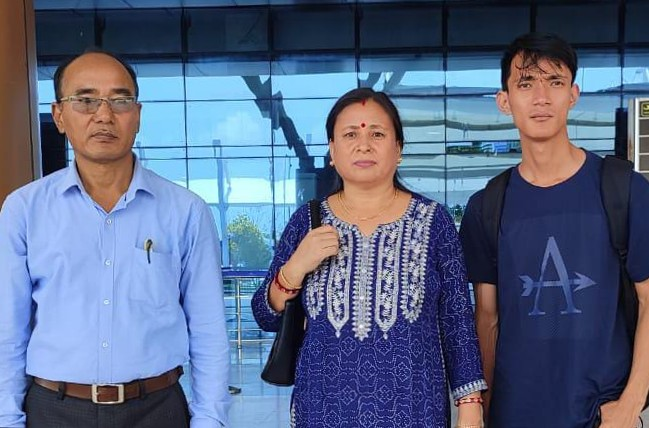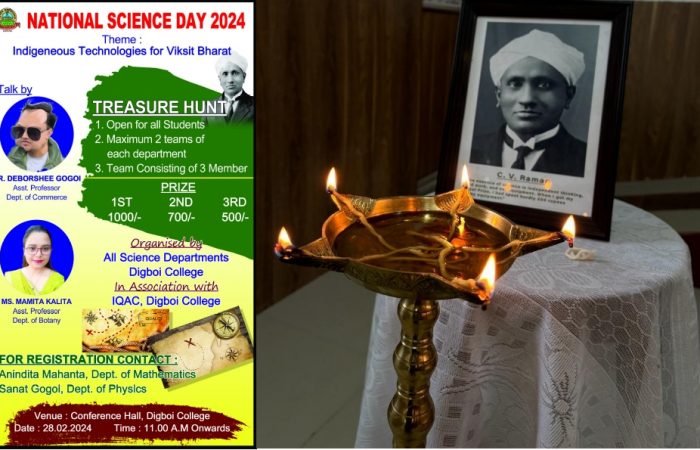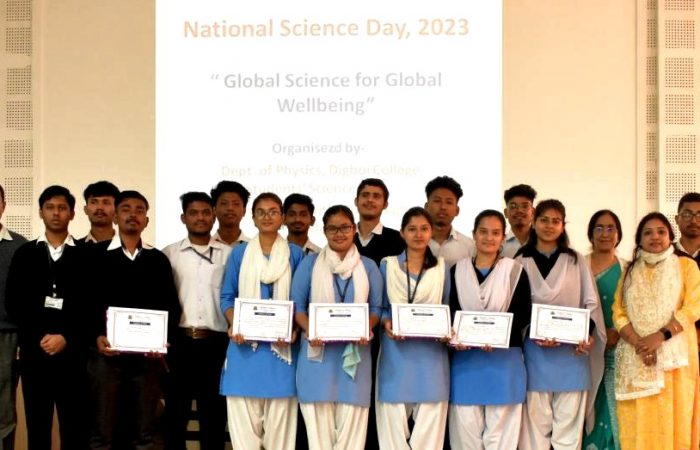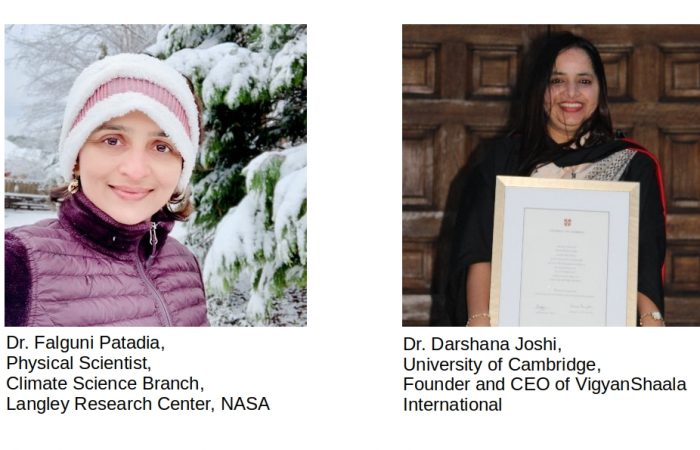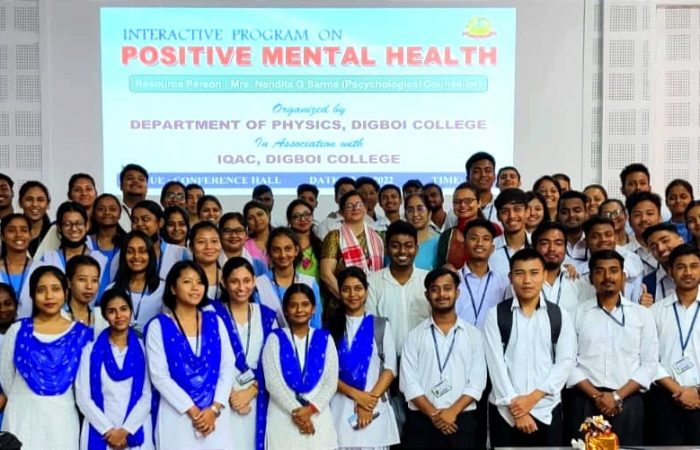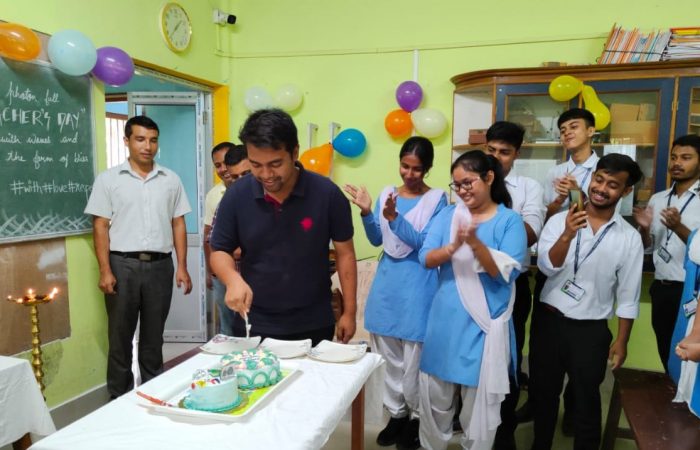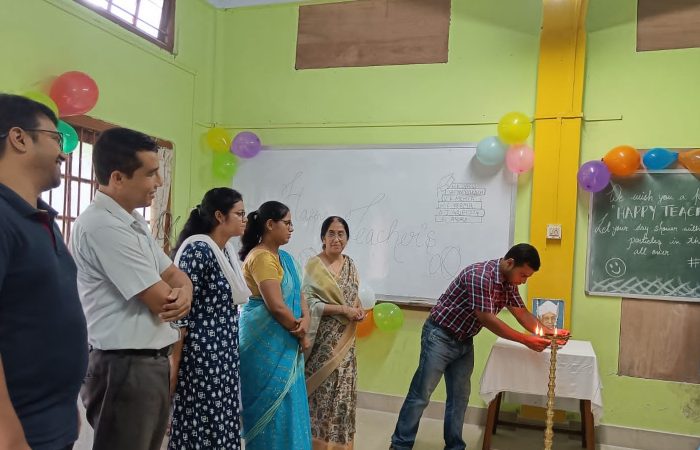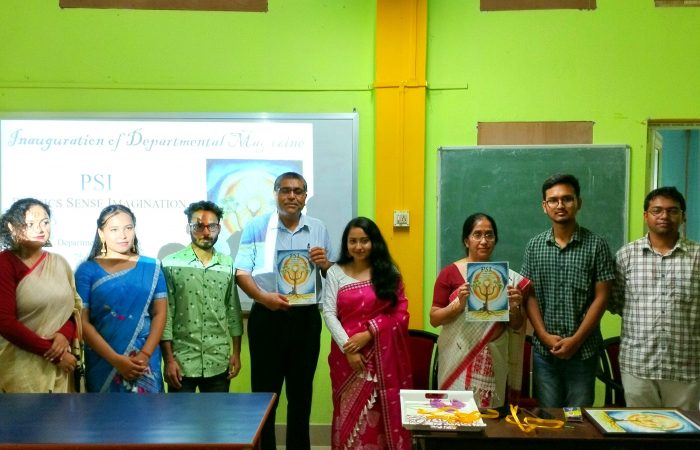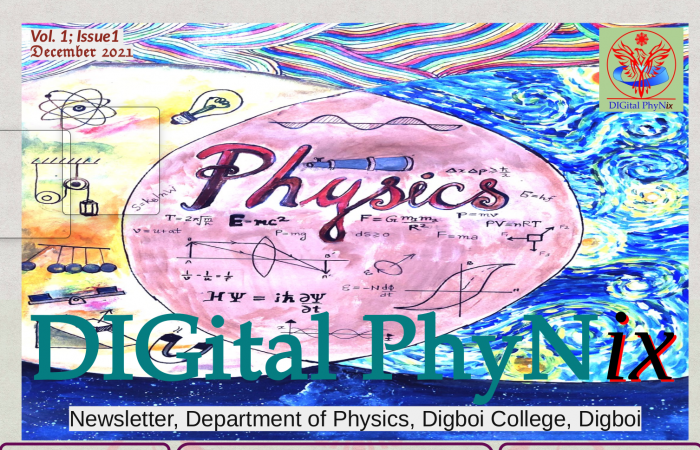Thank you for virtually visiting the Department of Physics, Digboi College. The department of physics at Digboi College was established in 1969. The department initially offered only a non-major undergraduate programme and has completed its glorious 50 years since then. The Physics department introduced the undergraduate BSc Honours Programme in Physics under Dibrugarh University in 1991 and the PG Programme in 2016. Department of Physics, Digboi College has been providing its service for developing a scientific mindset and bringing science to the doorstep of common people in this outskirt region of the nation. The department is equipped with top-class facilities and strengthened by experienced plus dynamic faculties to prepare the students to compete with the world and face real-life problems.
Non-Major B. Sc. Physics: 1969
B. Sc. in Physics Honours: 1991
M. Sc. in Physics under Dirbugarh University: 2016
Enrollment Capacity:: UG — 35 and PG — 20
Current Student Strength:
No. of Faculty — 6
No. of Laboratory Assistant — 2
Postal Address: Department of Physics
Digboi College, Digboi, Tinsukia
Assam 786171
Email id: digboicollegephysics[at]gmail.com

Year of Joining: 2019
Designation: Assistant Professor
Specialization: Condensed Matter Physics

Year of Joining: 2021
Designation: Assistant Professor
Specialization: Condensed Matter Physics

Year of Joining: 2008
Designation: Laboratory Assistant

Year of Joining: 2011
Designation: Laboratory Assistant
As per the regulation of Dibrugarh University and DHE, Assam the eligibility criteria for various courses are as follows:
As per the regulation of Dibrugarh University, the course structures are as follows:
| Sl. No. | Course | No. of Papers | Theory + Practical | Theory+ Tutorial |
|---|---|---|---|---|
| 1 | Core Course | 14 | 14 x 4 = 56 | 14 x 5 = 70 |
| 2 | Core Course Practical/Tutorial* | 14 | 14 x 2 = 28 | 14 x 1 = 14 |
| 3 | A.1. Discipline Specific Elective | 4 | 4 x 4 = 16 | 4 x 5 = 20 |
| 4 | A.2. Discipline Specific Elective Practical/Tutorial* | 4 | 4 x 2 = 8 | 4 x 1 = 4 |
| 5 | B.1. Generic Elective/ Interdisciplinary | 4 | 4 x 4 = 16 | 4 x 5 = 20 |
| 6 | B.2. Generic Elective Practical/Tutorial* | 4 | 4 x 2 = 8 | 4 x 1 = 4 |
| 7 | Ability Enhencement Compulsory | 3 | 3 x 2 = 6 | 3x 2 = 6 |
| 8 | Ability Enhencement Elective(Skill Based) | 2 | 2x 2 = 4 | 2 x 2 = 4 |
| 9 | Total | 49 | 142 | 142 |
| Sl. No. | Courses | No. of Papers | Credits per paper | Total Credits |
|---|---|---|---|---|
| 1 | Core Course | 12 | 4 | 12 x 4 = 48 |
| 2 | Discipline Specific Elective Course (DSE) | 5 (min) | 4 | 5 x 4 = 20 |
| 3 | Ability Enhancement Course (AEC) | 2 (min) | 2 | 2 x 2 = 04 |
| 4 | Generic Elective Course (GE) | 2 | 4 | 2 x 4 = 08 |
| 5 | Total Credit (Minimum) | 80 |
As per the regulation of Dibrugarh University the course outcome of various courses are as follows:
Please select the required semester. Thanks for going through the course Outcomes.
PHYSICS-C1 Mathematical Physics
Objective
Write a problem in Physics in the language of Mathematics.
Identify a range of diverse mathematical techniques to formulate and solve a problem in basic Physics.
Analyze some of the basic mathematical concepts and methods.
Apply the knowledge and understanding of these mathematical methods to solve problems in
a number of elementary branches of Physics like Mechanics, Electromagnetic Theory, Statistical
Physics, Thermal Physics, etc.
Learn computer programming and numerical analysis and know its role in solving problems in
Physics.
Construct a problem in Physics computationally.
Expected Learner Outcomes
Develop the requisite mathematical skills of a student to understand the fundamental topics in Physics.
Develop the ability of a student to critically analyze a topic.
Prepare a student for more advanced topics in Physics by providing a solid grip over the fundamental concepts in Physics.
Demonstrate the use and importance of computational methods in Physics and enable a student to construct a Physics problem computationally.
—————————————————–
PHYSICS-C2 Mechanics
Objective
Understand the basic concepts and ideas in mechanics- e.g., motion, force and torque, mass and
moment of inertia, linear and angular momentum, kinetic energy and potential energy, etc. by
parallel studies of linear dynamics and rotational dynamics.
Understand the basic conservation laws by studying them in various mechanical systems
including collisions, oscillations, gravitational systems, etc.
Analyze some of the basic mathematical concepts and methods.
Analyze simple harmonic oscillator in detail
Study planetary motions as a central force problem.
Understand the concept of frame of reference, the importance of relative transformations, and
invariance of laws of Physics.
Realize the consequences of non-inertial frame in our real physical world.
Know about the peculiar phenomena of special relativity which are not seen in Newtonian
relativity and to understand the concept of space-time.
Expected Learner Outcomes
Introduce the students to the basic concepts of mechanics.
Enable the students to understand conservation laws as they are the fundamental laws of nature and will help them in realizing a crucial phenomenon of nature- symmetry.
Enable the students to understand simple harmonic oscillator as it is a unique mechanical problem and will help them to understand the advanced treatment in quantum mechanics and modern Physics.
Develop knowledge of special relativity to understand relativistic formulation of modern theories.
Develop knowledge of mechanics which will help students in their everyday life.
—————————————————–
PHYSICS-GE1 Mechanics
Objective
Understand the basics of vector algebra and the techniques of solving ordinary differential equations.
Understand the basic components of mechanics- e.g. motion, force and torque, mass and moment of inertia, linear and angular momenta, kinetic energy and potential energy, etc., and the conservation theorems.
Study the mechanics of gravitational systems and simple harmonic motion.
Study the elastic behavior of materials.
Realize the idea of frame of reference and its implications in the study of special relativity.
Expected Learner Outcomes
Enable the students to analyze different phenomena due to the interaction of light with light and matter.
Train the students to use different optical instruments.
Help the students to understand various natural phenomena using different apparatus in the laboratory.
—————————————————–
PHYSICS-CIII Electricity and Magnetism
Objective
Gain basic knowledge of electricity and magnetism.
Understand the electrical and magnetic properties of matter in brief.
Understand the effect of electric field on magnetic field and the effect of magnetic field on current.
Understand the basic principle of the electrical circuit (AC) circuit and electrical networking.
Acquire basic theoretical as well as experimental skills in electrical networking.
Expected Learner Outcomes
Develop the basic theoretical knowledge as well as experimental skills of the students on electrical networking.
Train the students to handle and repair instruments based on electric and magnetic field effects.
—————————————————–
PHYSICS-CIV Waves and Optics
Objective
Learn the basics of wave motion.
Know about the behaviour of light due to its wave nature.
Identify and understand different phenomena due to the interaction of light with light and matter.
Analyze some of the fundamental laws and principles of light which is used in many important optical instruments.
Expected Learner Outcomes
Enable the students to analyze different phenomena due to the interaction of light with light and matter.
Train the students to use different optical instruments.
Help the students to understand various natural phenomena using different apparatus in the laboratory.
—————————————————–
PHYSICS-GE-2 Electricity and Magnetism
Objective
Understand basic knowledge of electricity and magnetism.
Understand basic knowledge of electrical and magnetic properties of matter in brief.
Understand the basic knowledge of the effect of electric field on magnetic field and the effect of magnetic field on current.
Understand the basic principle of the electrical circuit (AC) circuit and electrical networking.
Develop basic theoretical as well as experimental skills in electrical networking.
Expected Learner Outcomes
Perform quantitative analyses of basic problems in Electrostatics and Magnetodynamics.
Apply Gauss’s Law, Ampere’s Law, and Biot-Savart Law to solving practical problems in electricity and magnetism.
Apply the fundamental laws of electromagnetism to solve problems of electrostatics, magnetostatics, and electromagnetic induction
Explain and analyze the behavior of alternating currents in LCR circuits.
Perform and interpret the results of simple experiments and demonstrations of physical principles.
Solve problems relevant to interfaces between media with defined boundary conditions.
—————————————————–
PHYSICS-CV Mathematical Physics-II
Objective
Write a problem in Physics (slightly more advanced than those in Mathematical Physics I) in the language of Mathematics.
Identify a range of diverse mathematical techniques to formulate and solve a problem in basic Physics.
Analyze some of the useful mathematical methods.
Apply the knowledge and understanding of these mathematical methods to solve problems in a number of fundamental topics in Physics.
Construct a problem in Physics computationally.
Expected Learner Outcomes
Develop the requisite mathematical skills to understand some of the fundamental topics (slightly more advanced than those in Mathematical Physics I) in Physics.
Develop the ability of a student to critically analyze a topic.
Prepare a student for more advanced topics in Physics by providing a solid grip on the fundamental concepts in Physics.
Enable a student to understand the use and importance of computational/numerical methods in Physics and enable a student to construct a Physics problem computationally.
—————————————————–
PHYSICS-CVI Thermal Physics
Objective
Develop knowledge on the classical laws of thermodynamics and their application.
Use the knowledge of thermodynamics in various applications in allied fields like Materials science, Condensed matter Physics, Atmospheric Physics, Solar Physics, etc.
Probe questions in varied fields of Physics, chemistry, and biology-based on principles of Thermal Physics.
Use the concept of thermodynamics in real-world experiences
Develop critical and analytical thinking of the student on thermodynamics and allied disciplines.
Expected Learner Outcomes
Apply the laws of thermodynamics to real-world problems.
Conduct scientific problems and experiments on thermodynamics and allied disciplines.
Demonstrate a working knowledge of the physical principles in Thermal Physics.
—————————————————–
PHYSICS-CVII Digital Systems and Applications
Objective
Know about the basic laboratory equipment electronics.
Understand basic digital electronics concepts and devices.
Analyze digital circuits.
Expected Learner Outcomes
Identify and understand digital electronic principles and systems.
Apply the knowledge to analyze and apply digital circuits in solving circuit-level problems.
Build real-life applications using digital systems.
—————————————————–
PHYSICS-AECC-1 Electrical Circuits and Network Skills
Objective
Design and troubleshoot the electrical circuits, networks, and appliances through hands-on mode.
Build the basic foundation for learning electrical wirings and repairing other household equipment.
Expected Learner Outcomes
Design and troubleshoot certain electrical circuits and domestic appliances along with an understanding of the working of those appliances.
Do electrical wiring and repairing. This knowledge will develop the skill of the students for various electrical repairing and servicing purposes.
—————————————————–
PHYSICS-GE-3 Thermal Physics and Statistical Mechanics
Objective
Develop the working knowledge of the laws and methods of thermodynamics and elementary statistical mechanics.
Provide insight into the postulates of Statistical Mechanics and statistical interpretation of thermodynamics
Understand the laws of radiation and acquire knowledge for their applications in various disciplines in Physics, Chemistry, Biology, Earth and Atmospheric Sciences.
Develop application-oriented knowledge of laws of statistical mechanics in selected problems
Use the methodologies, conventions, and tools of thermal and statistical physics to test and communicate ideas and explanations.
Expected Learner Outcomes
Apply laws of thermodynamics and statistical mechanics to a range of situations in real-world problems.
Conduct scientific problems and experiments on thermodynamics and allied disciplines.
Demonstrate a working knowledge of the physical principles describing thermal physics.
Explain thermal physics as logical consequences of the postulates of statistical mechanics
—————————————————–
PHYSICS-CVIII Mathematical Physics III
Objective
Write a problem in Physics in the language of mathematics.
Identify a range of diverse mathematical techniques/ideas to formulate, simplify and solve some problems in Physics.
Analyze some of the useful mathematical ideas and techniques.
Apply the knowledge and understanding of these mathematical methods to solve problems in a number of fundamental topics in Physics.
Construct a problem in Physics computationally and use simulations to design an experiment.
Expected Learner Outcomes
Develop mathematical skills of a student to understand some of the fundamental topics.
Develop the ability of a student to critically analyze a topic.
Prepare a student for more advanced topics in Physics by providing a solid grip over the fundamental concepts in Physics.
Enable a student to understand the use and importance of computational/ numerical methods in Physics and to construct a problem computationally.
Help a student to pursue advanced studies in Physics.
—————————————————–
PHYSICS-CIX Elements of Modern Physics
Objective
Understand the theoretical basis for the understanding of quantum Physics as the basis for dealing with microscopic phenomena.
Apply concepts of 20th Century Modern Physics to deduce the structure of atoms.
Explain the wave-particle duality of the photon.
Analyze the structure of matter at its most fundamental.
Develop insight into the key principles and applications of Nuclear Physics
Expected Learner Outcomes
Understand and appreciate the theory of modern physics
Develop the ability to apply it in solving simple problems in Quantum Mechanics (QM), structure of atoms, Laser, and Nuclear Physics.
—————————————————–
PHYSICS-CX Analog Systems and Applications
Objective
Know about the basics of semiconductor PN junction, its various types and its application to different electronic circuits.
Understand bipolar junction transistors and their applications as amplifiers and oscillators.
Familiarize with operational amplifiers, their applications, and analysis.
Develop knowledge about analog to digital and digital to analog conversion techniques.
Expected Learner Outcomes
Learn the foundation knowledge of analog electronic systems.
Learn the working and applications of PN junction and bipolar junction transistors (BJT).
Learn to analyze circuits containing PN junction and BJT along with the application of BJT as amplifiers and oscillators.
Develop basic knowledge of operational amplifiers and their applications.
—————————————————–
PHYSICS-AEEC-2 Applied Optics
Objective
Learn about various optical devices, components, and systems.
Familiarize with experiments related to optoelectronic devices.
Learn about Fourier transform spectroscopy, holography, and various aspects of fiber optics.
Expected Learner Outcomes
Acquire knowledge about various optoelectronic devices and their applications.
Understand the basics of Laser and their uses.
Understand Fourier transform spectroscopy and will learn to use this technique for various purposes.
Learn the use of optical fibers and related information.
—————————————————–
PHYSICS-GE-4 Waves and Optics
Objective
Learn the basic ideas of the behavior of light based on its wave nature.
Develop the knowledge of the different phenomena due to the interaction of light among them and with matter.
Learn about some fundamental principles of light which are used in different optical instruments which very essential for Physics students.
Expected Learner Outcomes
Justify different phenomena due to light and the interaction of light among them and with matter.
Use different optical instruments.
Produce different natural phenomena using different apparatus in the laboratory.
—————————————————–
PHYSICS-CXI Quantum Mechanics and Applications
Objective
Know about the development of modern physics and the theoretical formulation of quantum mechanics.
Know the applications of quantum mechanics in solving physical problems.
Expected Learner Outcomes
Learn how to apply quantum mechanics to solve physical systems in different areas of science.
Know about the physical behavior of materials.
Learn how the scientific behavior of materials can be used for human applications.
—————————————————–
PHYSICS-CXII Solid State Physics
Objective
Familiarize with fundamentals of Solid State Physics.
Know about the structural, electronic, and lattice vibration-dependent behavior of solids.
Learn the basic concepts in hands-on mode through laboratory experiments associated with the course.
Expected Learner Outcomes
Equip a student with basic concepts of solid-state Physics so that the knowledge can be applied for further development of the subject.
Enable a student to work in both theoretical and experimental aspects of solid-state Physics.
Help the students in thorough learning of the concepts associated with the course through the laboratory experiments.
—————————————————–
PHYSICS-DSE-I Classical Dynamics
Objective
Understand the underlying facts in the development of classical mechanics and the advantages of its formulation over Newtonian mechanics.
Describe mechanics of a system in terms of equation of motion.
Understand Lagrangian formulation and Hamiltonian formulation of mechanics and their applications in mechanical problems.
Study the theoretical analysis of systems oscillating with small amplitudes.
Observe the peculiar phenomena when transformed from Newtonian relativity to special relativity and to understand the concept of space-time.
Expected Learner Outcomes
Prepare for the study of modern Physics.
Develop basic theoretical ingredients necessary to study advanced theoretical courses like quantum mechanics.
Learn a number of mathematical techniques applicable to Physics problems in different areas.
Develop knowledge of special relativity which is essential to understand the relativistic formulation of modern theories.
—————————————————–
PHYSICS-DSE-II Physics of Devices and Instruments
Objective
Know about various devices like UJT, FET, MOSFET, CMOS, etc., and their application to different electronic circuits.
Design rectifiers, passive and active filters, multivibrators, etc.
Familiarize with the IC fabrication techniques.
Learn about digital data communication standards and also about communication systems.
Expected Learner Outcomes
Develop knowledge about various devices like UJT, FET, etc., and use these devices for different applications.
Design and analyze filter circuits, power supply FET amplifiers, etc.
Develop the basic knowledge of IC fabrications, data communication standards, and communication systems.
—————————————————–
PHYSICS-DSE-II Astronomy and Astrophysics
Objective
Introduce the fundamental concepts of Astrophysics to the interested students.
Motivate students to pursue further study in the future in these challenging, fascinating, and important fields of Physics.
Expected Learner Outcomes
Equip the students with basic knowledge of Astrophysics.
Create interest in the subjects of Astrophysics and pursue further higher studies in the subject concerned in the future.
Develop the critically analyzing ability, which may motivate the students to solve any challenging physical problem in the future.
—————————————————–
PHYSICS-DSE-II Physics and Earth
Objective
Expected Learner Outcomes
Develop critical and quantitative thinking on scientific issues related to the study of cosmology and Earth Sciences.
Understand the basic principles of various processes of the Earth.
Apply the acquired knowledge to the study of the Universe
Pursue a career in Earth Sciences, Cosmology, etc.
Understand the contemporary dilemmas on Earth and Environmental issues like climate change, air pollution, deforestation, etc.
—————————————————–
PHYSICS-CXIII Electromagnetic Theory
Objective
Understand the physical and mathematical principles to provide an in-depth analysis of the behavior of electricity and magnetism in matter.
Apply Maxwell’s equations to explain the properties of the electromagnetic wave and its interaction with matter.
Analyze the principles and processes related to polarization, interference, and diffraction along with their applications to the development of waveguide and optical fibers.
Expected Learner Outcomes
Solve problems relevant to interfaces between media with defined boundary conditions.
Use Maxwell’s equations to describe the behavior of electromagnetic waves in vacuum as well as medium.
Describe states and methods of polarization and analyze the polarization state of a light source.
—————————————————–
PHYSICS-CIV Statistical Mechanics
Objective
Understand the physical and mathematical principles to provide an in-depth analysis of the behavior of electricity and magnetism in matter.
Apply Maxwell’s equations to explain the properties of the electromagnetic wave and its interaction with matter.
Analyze the principles and processes related to polarization, inthe terference, and diffraction along with their applications to the development of waveguide and optical fibers.
Expected Learner Outcomes
Solve problems relevant to interfaces between media with defined boundary conditions.
Use Maxwell’s equations to describe the behavior of electromagnetic waves in vacuum as well as medium.
Describe states and methods of polarization and analyze the polarization state of a light source.
—————————————————–
PHYSICS-DSE-III Nuclear and Particle Physics
Objective
Expected Learner Outcomes
Develop knowledge regarding nuclear and elementary particles as well as properties and phenomena related to them.
Successfully apply the same knowledge in solving problems in the field of nuclear and particle physics.
—————————————————–
PHYSICS-DSE-IV Nano Materials and Application
Objective
the Provide systematic coverage and insight into the promising area of nanomaterials in order to facilitate the understanding of the nature and prospects for the field.
Provide information about various synthesis and characterization techniques of nanomaterials.
Discuss optical and electronic transport properties of nanomaterials.
Discuss applications of nanomaterials.
Expected Learner Outcomes
Gather sufficient knowledge about the fascinating behavior of nanomaterials and tuning of such properties for different applications.
Obtain information on experimental methodologies with the necessary theoretical background, which may be useful for pursuing further study in the areas of nanoscience and technology.
—————————————————–
PHYSICS-DSE-IV Experimental Techniques
Objective
Enhance experimental knowledge.
Develop the theoretical as well as experimental knowledge of different instruments and instrumentation.
Enhance the knowledge of some measurement techniques and data and error analysis techniques.
Expected Learner Outcomes
Develop the theoretical as well as experimental knowledge of different instruments and instrumentation.
Develop the knowledge of some measurement techniques and data and error analysis techniques, which is very essential for a Physics student.
Handle different electrical network-based instruments.
—————————————————–
Please select the semester on right
PH-C-I Mathematical Physics
Objective
At the completion of this course, a student will be able to
(1) Write a. problem in higher-level Physics in the language of Mathematics.
(2) Identify a range of diverse mathematical techniques to formulate and solve a problem in higher-level physics.
(3) Analyze various mathematical concepts and methods.
(4) Apply the knowledge and understanding of these mathematical techniques to gain insight into a number of branches of physics like Quantum Mechanics, Electromagnetic Theory, Condens Matter Physics, Atomic and Molecular Physics, Nuclear Physics, Particle and High Energy Physics, Physics of Gravity, etc.
Expected Learner Outcomes
After the completion of this course, it is expected that this course will
(1) Equip students with the required mathematical skills to succeed in Physics.
(2) Develop the analyzing ability of the students to solve problems in Physics.
(3) Enable the students to pursue a research career in Physics and will ultimately help to contribute new knowledge.
—————————————————–
PH-C-II Quantum Mechanics
Objective
(1) Acquaint the learners with fundamental concepts of Quantum Mechanics.
(2) Acquaint the learners with Dirac notation.
(3) Enable the learners to solve simple quantum mechanical problems.
(4) Introduce the concepts of symmetry and conservation laws.
(5) Introduce the techniques of angular momentum algebra.
Expected Learner Outcomes
(1) Understand the basic concepts of quantum mechanics.
(2) Solve simple quantum mechanical problems.
(3) Understand quantum dynamics.
(4) Write down Eigen values and Eigen states of angular momentum.
—————————————————–
PH-C-III General Lab I
Objective
The objective of this course is to
(1) To develop practical knowledge by applying the experimental methods and to correlate with
the Physics theory.
(2) To learn the usage of electrical and optical systems for various measurements.
(3) To apply the analytical techniques and graphical analysis to interpret the experimental data.
(4) To learn error propagation and its role in making conclusions.
Expected Learner Outcomes
On successful completion of this course, students should be able to:
(1) Learn to minimize contributing variables and recognize the limitations of the equipment.
(2) Describe the methodology of science and the relationship between observation and theory.
(3) Participate in the methodology by performing laboratory exercises.
—————————————————–
PH-DSE-IA Theory of Relativity
Objective
The objective of this course is to
(1) Acquaint the learners with the special theory of relativity, space time continuum.
(2) Introduce the basic concepts of tensor calculus
(3) Introduce the learners to the general theory of relativity
Expected Learner Outcomes
After successful completion of the course the student will be able to
(1) Understand the ideas of space time continuum, four vectors.
(2) Understand tensors as geometrical objects, understand coordinate free formulation of physical laws.
(3) Understand the basic ideas of geometrical formulation of gravity.
(4) Understand basic ideas of cosmology.
—————————————————–
PH-DSE-IB Atmospheric Physics
Objective
The objective of this course is to
(1) Introduce the physics and chemistry of the Earth’s neutral atmosphere.
(2) Give an in depth introduction to the atmospheric thermodynamics.
(3) Introduce atmospheric aerosols and analyse its impact on the global climate.
Expected Learner Outcomes
This course will enable the students to
(1) Acquainted with the different layers of the atmosphere and the related physical phenomena.
(2) Develop simple models of the atmosphere.
(3) Understand the optical and microphysical properties of aerosol.
(4) Understand the atmospheric chemistry of trace gases.
—————————————————–
PH-AEC-IA Experimental Techniques
Objective
At the completion of this course, a student will be able to
(1) Understand the basic concepts of errors in measurements and techniques of data analysis.
(2) Understand the principle of sensors and transducers and OPAMP
Expected Learner Outcomes
This course will enable the students to
(1) Identify the errors in measurement.
(2) Analyze the working of various sensors and transducers.
—————————————————–
PH-AEC-IB Observational Astronomy
Objective
(1) Introduction to observational astronomy.
(2) Familiarisation with Coordinate systems, telescopes, and observational instruments (CCDs, filters, spectrographs)
(3) Familiarisation with Observational methods and techniques.
Expected Learner Outcomes
(1) Develop the knowledge of handling telescopes and other modern image processing devices.
(2) Describe the effects of the properties of light and Earth’s atmosphere on astronomical
observations, coordinate system for stars
(3) Acquire the knowledge of photometry and multi-wave astronomy
—————————————————–
PH-C-IV Classical Mechanics
Objective
1. Acquaint the learners with the subject of classical mechanics in the context of the language
and methods of modern nonlinear dynamics.
2. Enable the learners to make a smooth transition from classical mechanics to quantum
mechanics and nonlinear dynamics.
Expected Learner Outcomes
1. Understand the basic concepts of Lagrangian and Hamiltonian dynamics
2. Understand the basic concepts of modern nonlinear dynamics
3. Understand canonical and noncanonical flows
4. Make a smooth transition from classical to quantum mechanics
—————————————————–
PH-C-V Condensed Matter Physics
Objective
At the completion of this course, a student will be able to
1. Familiarize with fundamentals of Condensed Matter Physics.
2. Know about different lattice structures, behavior and importance of crystalline state, contribution of X-Ray Diffraction in Crystallography, the importance of defects and imperfections in a crystal etc.
3. Understand the behavior in solids that depend primarily on the motion of electrons inside the solid.
Expected Learner Outcomes
The course will
1. Equip a student with basic concepts of Condensed Matter Physics so that the knowledge can
be applied for further development of the subject.
2. Enable a student to work in both theoretical and experimental aspects of Condensed Matter Physics.
3. Help the students in thorough learning of the concepts associated with the course through the numerical, quizzes, assignments, projects, etc.
—————————————————–
PH-C-VI General Lab II
Objective
At the completion of this course, a student will be able to
1. Understand the basic techniques of design and analysis of simple transistor and OPAMP
circuit.
2. Apply the knowledge to design and study different electronic circuits.
Expected Learner Outcomes
This course will enable the students to
1. Design electronic circuits using various electronic components.
2. Analyze the circuits and understand their behaviors.
—————————————————–
PH-DSE-IIA Plasma Physics
Objective
The objective of the course is to
1. Understand the collective nature of plasma dynamics.
2. Describe the motion of charged particles in varying electric and magnetic fields.
3. Derive fluid description of collective plasma motion.
4. Learn the foundations of plasma waves and instabilities.
Expected Learner Outcomes
On completion of the course, the student shall be able to:
1. Define plasma and its fundamental parameters, distinguish the single-particle approach, fluid approach and kinetic statistical approach to describe different plasma phenomena
2. Determine the velocities (drift velocities) of charged particles moving in electric and magnetic fields that are either uniform or vary slowly in space and time
3. Classify the electrostatic and electromagnetic waves that can propagate in magnetized and non-magnetized plasmas, and describe the physical mechanisms generating these waves
4. Define and determine the basic transport phenomena such as plasma resistivity, diffusion (classical and anomalous) and mobility as a function of collision frequency and of the fundamental parameters for both magnetized and non-magnetised plasmas.
—————————————————–
PH-C-VII Electronics
Objective
1. To disseminate working knowledge of electronic principles using semiconductor devices
2. To allow students to learn the fundamentals of both analog and digital electronic devices
3. To allow students to apply their knowledge to designing small electronic systems.
4. To introduce students to advanced digital systems like microprocessors and microcontrollers
5. To imbibe the spirit of application-oriented learning
Expected Learner Outcomes
The student will be able to
1. Critically analyze analog and digital electronic circuits
2. Design small electronic systems as per design specifications
3. Write assembly language programs for doing simple arithmetic operations in microprocessor and microcontroller.
4. Apply their knowledge for real-life problems solving in electronic
—————————————————–
PH-C-VIII Electrodynamics
Objective
1. This course utilizes physical and mathematical principles to provide an in-depth analysis of the behavior of electricity and magnetism in matter.
2. To apprise the students regarding the concepts of electrodynamics and Maxwell equations and use them in various situations.
Expected Learner Outcomes
After completion of the course, students will be able to:
1. Describe the nature of electromagnetic waves and their propagation through different media and interfaces.
2. Explain charged particle dynamics and radiation from localized time-varying electromagnetic sources.
3. Understand potential formulation and magnetism in relativistic cases.
—————————————————–
PH-C-IX Computational Methods
Objective
After successful completion of the course, the student will
1. Get hands on training in problem solving using FORTRAN language in LINUX operating system.
2. Learn various numerical methods to solve physical problems as well as programming of such methods.
Expected Learner Outcomes
This course will enable the students to
1. Apply their knowledge on computer programming and numerical analysis in solving real physical problems.
2. Deal with scientific computing in different research areas of Physics.
—————————————————–
PH-DSE-IIIB Condensed Matter Physics
Objective
At the completion of this course, a student will be able to
1. Gather a broader knowledge of Electronic Properties of Solids.
2. Understand the chronology in the Development of the Electron theory in Metals.
3. Understand comparatively the Polarisation and Magnetisation behavior in a solid.
Expected Learner Outcomes
The course will
1. Equip a student with quantum mechanical tools for the solution of Condensed Matter Physics problems.
2. Enable a student to work in both theoretical and experimental aspects of Electronic Behavior of Solids.
3. Enable the students for further study and contribution towards the development of the subject.
—————————————————–
PH-DSE-IIIC Communication Electronics
Objective
At the completion of this course, a student will be able to
1. Understand the basic techniques of electronic communication like modulation, multiplexing, etc.
2. Apply the knowledge to understand the current generation communication technologies.
Expected Learner Outcomes
This course will enable the students to
1. Identify the basic techniques of communication like modulation, multiplexing.
2. Analyze the modulations schemes and their applicability.
3. Analyze present generation systems related to microwave communication, cellular
communications, satellite communication.
—————————————————–
PH-AEC-IIC Meteorology
Objective
1. Make familiar with the Earth’s atmosphere as well as the weather and climate systems.
2. Provide basic knowledge on meteorological parameters and their measurement techniques.
3. Apply the laws of Physics to explain Atmospheric phenomena.
4. Get familiar with weather forecasting.
Expected Learner Outcomes
After completion of the course, a student will be able to
1. Demonstrate the various atmospheric phenomena and their evolution.
2. Solve problems in the atmospheric sciences and related disciplines.
3. Impart expertise in sub-disciplines of atmospheric science or related interdisciplinary areas.
4. Develop skills for interpreting and applying atmospheric observation.
5. Serve as a meteorologist, climate scientist, and take part in policy making.
—————————————————–
PH-C-X Nuclear Physics
Objective
After successful completion of the course, the student will
1. Have a basic knowledge of the nuclear force and its properties.
2. Be able to visualize the nature of the interaction of nucleons inside deuteron nucleus as well as in general nucleon-nucleon scattering.
3. Be acquire knowledge about different theoretical models regarding nucleus as well as apply those in determining nuclear properties.
4. Grasp knowledge about nuclear reactions and their various mechanisms along with a wide understanding of the decay process.
5. Understand the basic forces in nature and classification of particles and study in detail conservation laws and quark models in detail.
6. Know the basic working principles of various nuclear detectors.
Expected Learner Outcomes
This course will enable the students to
1. Develop knowledge regarding nucleus, its properties, nuclear force, nuclear reactions and mechanisms, nuclear detectors as well as elementary particles and the properties related to them
2. Successfully apply the same knowledge in solving problems in the field of nuclear and particle physics.
—————————————————–
PH-C-XI Statistical Mechanics
Objective
Statistical Mechanics is one of the most important branches of physics which is required to understand the properties of matter in bulk on the basis of the dynamical behaviors of its microscopic constituents. As such the objectives of this course are:
(1) To introduce the advanced concepts of Statistical Mechanics so that students will be equipped with sufficient knowledge of the subject.
(2) To develop the critical thinking ability of students to understand the diverse physical phenomena.
(3) To develop the interest and ability among students to solve challenging physical problems by the application of techniques of Statistical Mechanics in the future.
Expected Learner Outcomes
After the completion of this course, it is expected that:
(1) The students will be equipped with sufficient knowledge of Statistical Mechanics and
hence will be able to look critically for analyzing any physical phenomena.
(2) May motivate students to solve any challenging physical problem in the future.
(3) Will draw interest to the subject to pursue further higher study in the future and will ultimately help to contribute new knowledge.
—————————————————–
PH-C-XII Atomic and Molecular Physics
Objective
The objective of this course is to make a student.
1. Learn the physics of the atoms and molecules.
2. Become familiar with various branches of spectroscopy and their applications.
3. Equip with basic spectroscopic techniques and instrumentation.
4. Learn to use spectroscopic techniques to identify materials.
5. Learn theoretical background of laser and its application in various disciplines.
Expected Learner Outcomes
After completing this course a student can
1. Determine the atomic and molecular structures.
2. Analyze and demonstrate a spectra to identify and quantify information about atoms and
molecules.
3. Demonstrate the interaction of electromagnetic spectra with matter and the associated type of
spectroscopy.
4. Identify elements present in a sample and in the universe using spectroscopic techniques
5. Apply knowledge of spectroscopy or laser spectroscopy in various disciplines of Physics, Chemistry, Atmospheric Science, Astronomy, Laser Communication, remote sensing, etc.
—————————————————–
PH-DSE-IVB Condensed Matter Physics II
Objective
The objective of the course is to
1. Provide basic knowledge on Lattice vibration and some properties of solid related to lattice vibration.
2. Develop the basic knowledge of thin-film Physics. It will provide the knowledge of preparation and characterization of thin films and their application in devices.
3. Enhance the knowledge of semiconducting properties and optical effects in semiconductors.
Expected Learner Outcomes
After the completion of the course, the student will be able to
1. Use the knowledge in the fabrication of different thin-film semiconductor devices.
2. Pursue some research or project work on the semiconducting thin-film devices.
—————————————————–
PH-DSE-IVC Digital and Optical Electronics
Objective
1. Introduce students to microcontrollers and programming for building digital systems.
2. Introduce students to digital signal and signal processing principles.
3. Introduce students to optical-electronic systems.
4. Provide students with fundamental principles of optical devices.
5. Introduce students to optical communication systems.
Expected Learner Outcomes
The student will be able to
1. Critically analyze microcontroller-based digital electronic circuits
2. Write assembly language programs for microprocessor and microcontroller-controlled devices.
3. Analyze optical-electronic devices
4. Critically analyze optical communication systems
5. Apply the knowledge of optical electronics to make innovative optical products for real life
problem-solving.
—————————————————–
Thanks for going through Course Outcomes.

